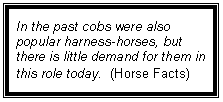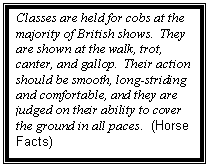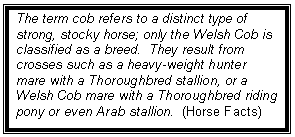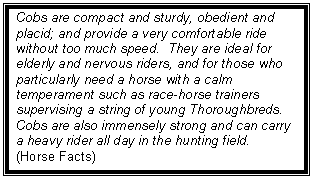|
|
|
Cob |
|
|
|
|
|
Cob |
|
|

The Cob is a 'stuffy,' short-legged type of horse, standing up to 15.2 hands high, with a small head set on an elegantly arched neck, a short, deep body and ample quarters. He should give a comfortable ride and have an infinitely placid, obedient temperament. A good Cob makes a wonderful ride for elderly or nervous riders and, as a hunter, what he lacks in speed he will make up for in handiness and good manners. There is not basic breeding pattern for producing a good cob, and many of the best are the result of chance crosses. As with the Hack and the Hunter, many of the best Cobs may be seen in the show ring. The Cob always used to be shown with docked tail and hogged mane, a fashion which emphasized his stocky appearance. The Docking and Nicking Act, passed in Britain in 1948, made the practice of docking horses' tails illegal. It is, however, still usual to hog a Cob's mane. (Enc. Horse 1983)
Originating in Britain, the Cob is a "type" rather than a breed. While Cobs may be found around the world, they are predominately found throughout Great Britain. The average height for a cob is between 14.2 and 15.2 hands high (58-62", 147-157cm). Some may be as tall as 16 hands and they can be any color. It is compact and muscular and suitable for hunting, showing and general riding. The term "cob" came into use in the 18th century. Prior to that, horses of this type were referred to as "rouncies," which is derived from feudal times -- Squires rode them into battle and estate stewards rode them during times of peace. Cobs are generally produced by chance and are often the by-product of Hunter breeding. Welsh Cobs are an exception to this type class and are classed as a breed. Often Welsh Cobs are used in the production of cob-type riding horses.
 Breeding stock is highly varied, with
Highland ponies, small
Thoroughbreds,
Suffolk Punches,
Arabs, and
Hunters often used as breeding stock. A Cob is not a tall horse, but it usually has considerable substance and can carry heavier riders. Since there is no sure method of breeding a Cob, they are most likely to result from crossing a heavyweight hunter with perhaps some heavy horse blood or an Irish Draught with a Thoroughbred or near Thoroughbred.
Breeding stock is highly varied, with
Highland ponies, small
Thoroughbreds,
Suffolk Punches,
Arabs, and
Hunters often used as breeding stock. A Cob is not a tall horse, but it usually has considerable substance and can carry heavier riders. Since there is no sure method of breeding a Cob, they are most likely to result from crossing a heavyweight hunter with perhaps some heavy horse blood or an Irish Draught with a Thoroughbred or near Thoroughbred.
The Cobís head should be small, pony-like and with good quality without any suggestion of coarseness. Its strong neck is muscular, crested and elegant. The well-sloped shoulder should be strong, muscular and sloping. The deep, broad body has a short strong back and rounded quarters. There should be great depth through the girth. Hindquarters should be generous and round with a high-set tail. Its limbs are short with plenty of bone and very short cannons. There should be no coarseness in the limbs. The Cob should have round hard feet.
The Cob should display low action from the shoulder and should be able to gallop well. These sturdy, compact horses are sometimes referred to as 'heavyweight hunters on short legsí (Ultimate Horse). Typically billed as the ideal mount for a more elderly, less athletic ride, the Cob should not give the impression of a dull slug. Cobs DO have a calm, steady ride and impeccable manners. They should also be active and willing, so that they may provide a rider with a safe and enjoyable dayís hunting. While they may not compete at the highest level due to their stocky builds, Cobs should be able to participate in a variety of competitive events. The Cob possesses considerable jumping ability, with a common sense which usually ensures safety and willingness in accomplishing tasks t it is asked to perform.
 Cobs generally have a very tractable temperament with high-class manners. They make an excellent ride for nervous or older riders. Race horse trainers often use a Cob to watch their horses at work. The Cob is also an excellent hunter over rough country, and is often used by heavy riders who donít wish to travel too fast on the hunt. Cobs up to 15.1 hands high are popular as show horses at most major shows in Great Britain. Taller Cobs are not permissible as a show Cob in Britain. A Cob is show hogged (a British term for roaching) and with a full tail. Until the passing of the Docking and Nicking Act in 1948, Cobs were shown docked.
Cobs generally have a very tractable temperament with high-class manners. They make an excellent ride for nervous or older riders. Race horse trainers often use a Cob to watch their horses at work. The Cob is also an excellent hunter over rough country, and is often used by heavy riders who donít wish to travel too fast on the hunt. Cobs up to 15.1 hands high are popular as show horses at most major shows in Great Britain. Taller Cobs are not permissible as a show Cob in Britain. A Cob is show hogged (a British term for roaching) and with a full tail. Until the passing of the Docking and Nicking Act in 1948, Cobs were shown docked.
Roaching gives the Cob a jaunty, sporting look. Its short, arched neck runs smoothly into powerful sufficiently sloped shoulders. The Cob has unmistakably strong quarters, with great weight-carrying capacity. There is great depth of girth which makes the short, well-muscled legs look even shorter. Legs have plenty of bone, and possess big, flat joints.
The percentage of heavy horse blood in many Cobs allows them to live out more readily than their better-bred relatives. The Cob has been influenced by Irish Draught, which provided bone, strength, substance and good sense. A touch of the Thoroughbred gave refining and riding quality. The Welsh Cob provided power, excellent legs and hooves, and some character. Some very good cobs are bred in Ireland form Irish Draft crosses, and some are pure Irish Draft. Welsh Cobs are another source, and there are cobs that have been bred from heavy horse breeds, such as the Shire, crossed with small Thoroughbreds, or from Cleveland Bays. On the whole, the breeding of cobs is likely to be accidental rather than deliberate.
 While the Cob is immediately recognizable and is a very appealing horse, it is not a breed. There is no set pattern to its production. The Cob is used both under saddle and in harness in Britain as an all-around horse. Cobs are often used as modern Roadsters.
While the Cob is immediately recognizable and is a very appealing horse, it is not a breed. There is no set pattern to its production. The Cob is used both under saddle and in harness in Britain as an all-around horse. Cobs are often used as modern Roadsters.
Cobs (those standing up to 15.1 hh) are exhibited in British show classes with their manes roached, and are expected to walk, trot, canter, and gallop. The traditional practice of roaching sets off the strong, short neck and gives the horse a jaunty, sporting look. Otherwise, the cob is thickset, with powerful quarters and short, strong legs. It is a structure that is predisposed to the carrying of weight rather than speed, although cobs are still expected to gallop and jump. Above all, a cob, while being a "character," must also have the best of manners. He is considered to be a "gentleman's gentleman," and is expected to behave as such.
For more information visit:

|
© 1997-2007
NW Breyer Horse Club & Refiner of Gold Creations Equinealities in place since 1997, Section in place 2001, Updated 3/13/2007 |



|
| ||

|
|||||